
The tree ferns are arborescent (tree-like) ferns that grow with a trunk elevating the fronds above ground level, making them trees. Most tree ferns are members of the "core tree ferns", belonging to the families Cyatheaceae, Dicksoniaceae, Metaxyaceae, and Cibotiaceae in the order Cyatheales. It is estimated that Cyatheales originated in the early Jurassic, and is the third group of ferns known to have given rise to tree-like forms. The others are the extinct Tempskya of uncertain position, and Osmundales where the extinct Guaireaceae and some members of Osmundaceae also grew into trees. In addition there was the Psaroniaceae and Tietea in the Marattiales, which is the sister group to true ferns.

This article relates to the flora of New Zealand, especially indigenous strains. New Zealand's geographical isolation has meant the country has developed a unique variety of native flora. However, human migration has led to the importation of many other plants as well as widespread damage to the indigenous flora, especially after the advent of European colonisation, due to the combined efforts of farmers and specialised societies dedicated to importing European plants & animals.

Dicksonia is a genus of tree ferns in the order Cyatheales. It is regarded as related to Cyathea, but is considered to retain more primitive traits, dating back at least to the Jurassic and Cretaceous periods. The fossil record includes stems, pinnules, and spores.

The biodiversity of New Caledonia is of exceptional biological and paleoecological interest. It is frequently referred to as a biodiversity hotspot. The country is a large South Pacific archipelago with a total land area of more than 18,000 square kilometres (6,900 sq mi). The terrain includes a variety of reefs, atolls, small islands, and a variety of topographical and edaphic regions on the largest island, all of which promote the development of unusually concentrated biodiversity. The region's climate is oceanic and tropical.

Pseudopanax is a small genus of 12–20 species of evergreen plants, the majority of which are endemic to New Zealand. Flowers of the genus occur in terminal umbels.

Dicksoniaceae is a group of tropical, subtropical and warm temperate ferns, treated as a family in the Pteridophyte Phylogeny Group classification of 2016, and counting 30-40 species. Alternatively, the family may be sunk into a very broadly defined family Cyatheaceae sensu lato as the subfamily Dicksonioideae. Most of the genera in the family are terrestrial ferns or have very short trunks compared to tree ferns of the family Cyatheaceae sensu stricto. However, some of the larger species can reach several metres in height. A number of others are epiphytes. They are found mostly in tropical regions in the Southern Hemisphere, as far south as southern New Zealand. Larger tree ferns in the genus Cibotium were formerly included in Dicksoniaceae, but are now segregated as the family Cibotiaceae.
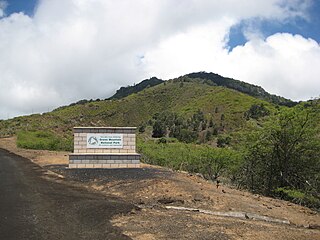
Green Mountain is a common name for "The Peak", the highest point on Ascension Island, which has gained some fame for claims that it is one of very few large-scale artificial forests.
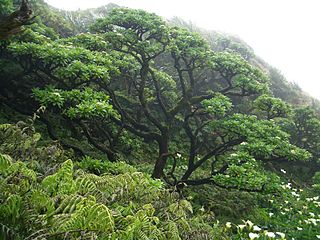
The Saint Helena scrub and woodlands ecoregion covers the volcanic island of Saint Helena in the South Atlantic Ocean. The island's remote location gave rise to many endemic species. First discovered and settled in the 1500s, the island has been degraded by human activities. Most of its native habitat has been destroyed, and many of its unique plants and animals are extinct or endangered.
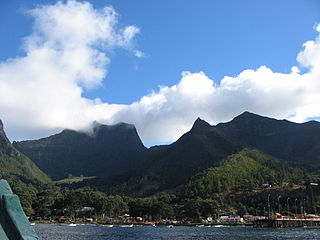
Archipiélago de Juan Fernández National Park is a national park located in the Pacific Ocean 665 kilometres west of Chile's mainland port of San Antonio, in the Juan Fernández Archipelago. The park covers 96 square kilometres and comprises the Santa Clara, Alejandro Selkirk and the most part of the Robinson Crusoe Island islands.

The flora of Saint Helena, an isolated island in the South Atlantic Ocean, is exceptional in its high level of endemism and the severe threats facing the survival of the flora. In phytogeography, it is in the phytochorion St. Helena and Ascension Region of the African Subkingdom, in the Paleotropical Kingdom.

Nesohedyotis is a genus of flowering plants endemic to the island of Saint Helena in the South Atlantic Ocean. It in the family Rubiaceae.

The flora of Australia comprises a vast assemblage of plant species estimated to over 30,000 vascular and 14,000 non-vascular plants, 250,000 species of fungi and over 3,000 lichens. The flora has strong affinities with the flora of Gondwana, and below the family level has a highly endemic angiosperm flora whose diversity was shaped by the effects of continental drift and climate change since the Cretaceous. Prominent features of the Australian flora are adaptations to aridity and fire which include scleromorphy and serotiny. These adaptations are common in species from the large and well-known families Proteaceae (Banksia), Myrtaceae, and Fabaceae.

A plant community is a collection or association of plant species within a designated geographical unit, which forms a relatively uniform patch, distinguishable from neighboring patches of different vegetation types. The components of each plant community are influenced by soil type, topography, climate and human disturbance. In many cases there are several soil types present within a given plant community. This is because the soil type within an area is influenced by two factors, the rate at which water infiltrates or exits the soil, as well as the rate at which organic matter enters or decays from the soil. Plant communities are studied substantially by ecologists, due to providing information on the effects of dispersal, tolerance to environmental conditions, and response to disturbance of a variety of plant species, information valuable to the comprehension of various plant community dynamics.
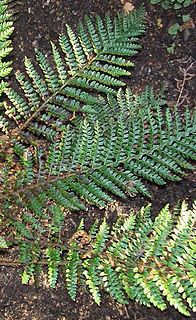
Polystichum proliferum, commonly known as mother shield fern is an Australian endemic fern. The genus name Polystichum is derived from Greek poly - many, and stichos - rows referring to the many rows of sori. The species name is derived from Latin, Proli – offspring and fer - bearing referring to the proliferous buds, a prominent feature of the species.
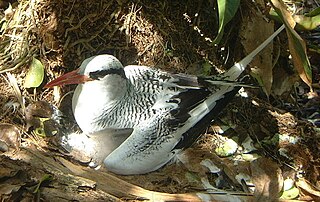
The South-west Saint Helena Important Bird Area is a 45 km2 tract of land covering about 37% of the island of Saint Helena, a British Overseas Territory in the South Atlantic Ocean. It has been identified by BirdLife International as an Important Bird Area (IBA) because it supports several colonies of breeding seabirds, including the red-billed tropicbird, as well as habitat of the endemic, and critically endangered, Saint Helena plover.

The flora of Madagascar consists of more than 12,000 species of plants, as well as a poorly known number of fungi and algae. Around 83% of Madagascar's vascular plants are found only on the island. These endemics include five plant families, 85% of the over 900 orchid species, around 200 species of palms, and such emblematic species as the traveller's tree, six species of baobab and the Madagascar periwinkle. The high degree of endemism is due to Madagascar's long isolation following its separation from the African and Indian landmasses in the Mesozoic, 150–160 and 84–91 million years ago, respectively. However, few plant lineages remain from the ancient Gondwanan flora; most extant plant groups immigrated via across-ocean dispersal well after continental break-up.
Tasmania is home to 'Australia’s largest cool temperate rainforests... Most of Tasmania’s rainforests occur in the North-West and throughout the North East highlands. Cool temperate rainforests typically have a heavy rainfall, cool climate, favor high altitudes and have a limited availability of light.
Dicksonia lanata is a fern endemic to New Zealand. Colloquial names include stumpy tree fern, tūākura and tūōkura.

The Tristan da Cunha–Gough Islands shrub and grasslands is a terrestrial ecoregion which covers the Tristan da Cunha archipelago and Gough Island in the South Atlantic Ocean. The islands' remote location gave rise to many endemic species.


















